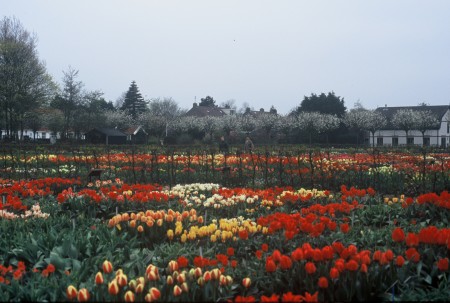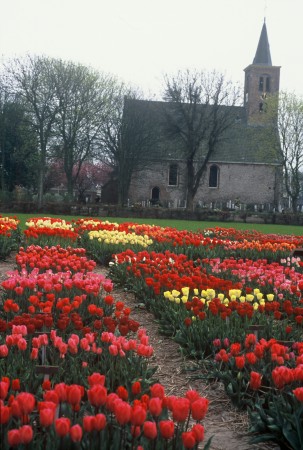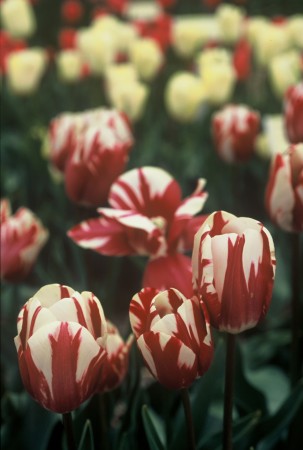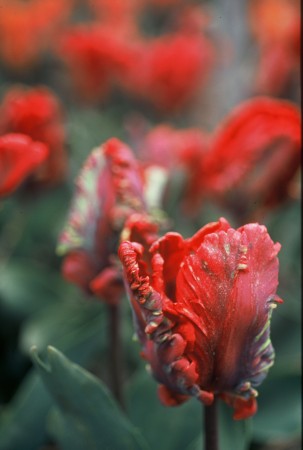 Just call me a relic. That’s right — rub it in — I’m obsolete. And guess what. Some of my best friends are equally archaic. And here comes the confession — my garden is a total museum. If something is old (the older, the better), I automatically yearn to grow it. It’s not hip, it’s not keeping up with the Joneses, it’s not riding the current wave, but it’s me. And when people come to my garden, they are clearly just being polite…because they seemingly love hearing the stories behind the auricula primroses that Flemish weavers grew during the cottage industry era and the Phlox ‘Old Cellar Hole’ dug up by my friend at Perennial Pleasures Nursery from an abandoned homestead.
Just call me a relic. That’s right — rub it in — I’m obsolete. And guess what. Some of my best friends are equally archaic. And here comes the confession — my garden is a total museum. If something is old (the older, the better), I automatically yearn to grow it. It’s not hip, it’s not keeping up with the Joneses, it’s not riding the current wave, but it’s me. And when people come to my garden, they are clearly just being polite…because they seemingly love hearing the stories behind the auricula primroses that Flemish weavers grew during the cottage industry era and the Phlox ‘Old Cellar Hole’ dug up by my friend at Perennial Pleasures Nursery from an abandoned homestead.
I realize that the topic was primarily heirloom vegetables in Noel’s post a few weeks ago (I would’ve joined in the fray but I was on the road — lecturing about Garden Stewardship). And I disagree on that point as well. But the post also cast stones at heirloom flowers. So I’m going to take that volley and carry it right into the bulb venue. I’m going to tell you about Hortus Bulborum.
 Hortus Bulborum is a garden of has-beens. It’s located on 5 acres in the sleepy little town of Limmen, Netherlands and it’s devoted to stewarding tulips, daffodils, hyacinths, and fritillarias. Hortus Bulborum (www.hortus-bulborum.nl) makes no bones about the fact that it is a musuem. In 1924, Pieter Boschman — a school headmaster — realized that tulips were facing a dismal destiny and decided to do something about it. Ever since, the museum plants tulips no longer actively listed in the trade. Because, if they weren’t replanted, those tulips would just disappear. Gone. And someday, when someone wanted a Tulipa ‘Gele Prins’ (1780) or T. ‘Mystery of India’ (previous to 1910), finding it would be hopeless.
Hortus Bulborum is a garden of has-beens. It’s located on 5 acres in the sleepy little town of Limmen, Netherlands and it’s devoted to stewarding tulips, daffodils, hyacinths, and fritillarias. Hortus Bulborum (www.hortus-bulborum.nl) makes no bones about the fact that it is a musuem. In 1924, Pieter Boschman — a school headmaster — realized that tulips were facing a dismal destiny and decided to do something about it. Ever since, the museum plants tulips no longer actively listed in the trade. Because, if they weren’t replanted, those tulips would just disappear. Gone. And someday, when someone wanted a Tulipa ‘Gele Prins’ (1780) or T. ‘Mystery of India’ (previous to 1910), finding it would be hopeless.
Let’s get real. Gardening is not necessarily driven by a straight tangent toward selecting the finest varieties. Instead, it has everything to do with fashion. Sure, some tulips weren’t worthy; some tulips of the past were virus-riddled and they deserved to disappear. But more often, tulips just slip out of cultivation due to rainbow chasing. The competitive market has everything to do with the swings of the popularity pendulum. More often than not, tulips that go in and out of vogue are abandoned because that particular color isn’t cool anymore. Or maybe the style of flower is so 1990s and we’ve moved on to 2011. Or maybe the name is boring.
Plant purveyors dance to whatever beat happens to be playing in the streets at the moment. I’m not saying that’s a bad thing — merchants must make a living. But it’s critical to understand that tulips (and other plants) that disappear from the popular trade are not necessarily inferior in any way. They’re just old. And we all know how modern society treats things that grow old.
For sure, tulips have progressed. Great strides have been taken in all avenues of horticulture, I don’t deny it. But when Old House Gardens wants to offer a 16th Century tulip for those of us who are relics, they have somewhere to turn. Or maybe a breeder suddenly needs to use a certain tulip as a parent. If it weren’t for Hortus Bulborum, they’d be out of luck. With 4,200 spring flowering historic bulbs under their wing, Hortus Bulborum is an invaluable resource. They plant 50 bulbs each of heirloom varieties in 2 1/2 acres of gardens (half the property is allowed to go fallow every year). In their garden, the first Dutch sport of a Turkish tulip species — ‘Duc van Tol Red and Yellow’ (circa 1595) is flourishing. In some people’s eyes, it’s so “gone with the wind.” But others of us just want to be able to grow this heirloom flower here and now. And gardening is notoriously fickle. Maybe we should all be museums. Maybe we should all consider stewarding plants that we love — in case they fall by the wayside. Just an idea.
For the record — I grow plants in both my flower and vegetable gardens that are old and new. And I salute Hortus Bulborum and Old House Gardens for making these bulbs available. And by the way, I garden in 1950s shirt-waist dresses. I’m sure that I would cut a sharper image dressed in jeans, like everyone else. But sorry. I prefer soft, gently-used, vintage dresses — pass-me-downs from someone in another generation who was just my size.
I’ll tell you what = you wear what you want and fill your garden solely with the newest and latest. And I’ll do my thing. But when you need to find an aromatic Viola odorata ‘Marie Louise’, and the last double fragrant Parma violet is gone because florists are breeding for longer stems right now — don’t come crying to me…



